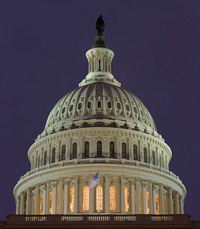

Tuesday - December 18, 2007
SLAC Today is available online at:
http://today.slac.stanford.edu
In this issue:
The Fiscal Year 2008 Budget
Safety Today: Christmas Tree Fire Hazard
SLAC to Celebrate the Holidays on Wednesday
Shipping and Receiving to Remain Open During Shutdown
 |
 |
|
Tuesday - December 18, 2007 |
 The Fiscal Year 2008 BudgetThe omnibus funding bill for the fiscal year 2008 budget is now public. It has still to be approved by the Senate and signed by the President and nothing is definite or settled until that happens. The bill includes the FY 2008 budget for the Office of Science. The FY08 budget figure is significantly reduced from the original FY08 President's request that came out in February. It is too early for me to say exactly what this means for SLAC and U.S. physical sciences, but both High-Energy Physics (HEP) and Basic Energy Sciences (BES) budgets are lower than anticipated. I will keep you informed and updated as the implications of the 2008 budget become clearer. The President's FY08 request asked for $1499M for BES—the figure in the omnibus bill is $1282M. The President's FY08 request was $782M for HEP—the HEP budget in the omnibus bill is $695M. The bill gives specific information on funding changes for HEP. The International Linear Collider (ILC) R&D will receive $15M, as opposed to $60M in the President's request. R&D for Super Conducting Radio Frequency (SCRF) work—which is relevant to the ILC—will be $5.45M, down from $23M in the President's request. These decisions will certainly be a major blow to ILC progress both at SLAC and internationally. No funds are provided to NOvA in the Tevatron complex improvements. There is very welcome news that the Linac Coherent Light Source (LCLS) will be fully funded for FY08. We don't yet know the details of the other BES programs. Overall, the reduction in the Office of Science budget is not good news for the physical sciences in the U.S. SLAC and other national labs will certainly feel the impact of these budget figures. |
||
|
|
||

Christmas Tree
|
SLAC to Celebrate the Holidays on Wednesday
It's that time of year again—you are cordially invited to SLAC's annual holiday party. So put down your tools, power down your instruments or log off your computer and head to the Panofsky Auditorium breezeway tomorrow starting at 11:00 a.m. Small prizes will be awarded for those who show the most holiday spirit by dressing in holiday colors. A buffet lunch will be available from 11:00 a.m. until 1:00 p.m. in the cafeteria, with three entree choices: oven-roasted turkey breast with cranberry sauce, smoked ham with pineapple-honey glaze and butternut squash ravioli with marinara sauce. At 11:15 a.m. the movie The Polar Express will be shown in the Panofsky Auditorium, and raffle prizes will be given away continuously between 11:30 a.m. and 1:00 p.m. You must be present to win, unless you work on owl or swing shift. More information is available at the holiday party webpage.
Hope to see you there!
|
Events (see all | submit)
Access (see all)
Announcements
|
| | ||
|
|
||
 <%
Response.AddHeader "Last-modified", getArticleDate()
'Response.AddHeader "Last-modified","Mon, 01 Sep 1997 01:03:33 GMT"
'Monday, December 06, 2010
%>
<%
Response.AddHeader "Last-modified", getArticleDate()
'Response.AddHeader "Last-modified","Mon, 01 Sep 1997 01:03:33 GMT"
'Monday, December 06, 2010
%>View online at http://today.slac.stanford.edu/ |
||